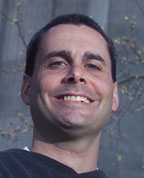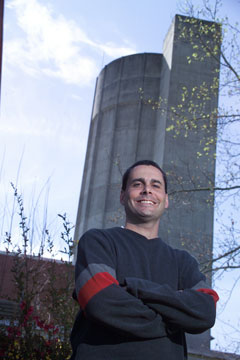| Research
|
Dan Bardayan, an astrophysicist at DOE's Oak Ridge National Laboratory, hails from nearby Nashville, Tenn., home of a galaxy of country music stars. However, the stars that interest him most are those in the cosmos. Bardayan has often been cited for pioneering work at the Holifield Radioactive Ion Beam Facility, even going back to his student days, when one of his papers changed the conventional wisdom on the expected amounts of some nuclei produced in exploding stars by factors of as much as 10,000. That paper won him the American Physical Society's 2001 dissertation in nuclear physics award, which cites the best dissertation in nuclear physics over a two-year period by a graduate student in North America. Bardayan's research in the Physics Division explores the nuclear processes in supernovae that create many of the elements responsible for life on earth. Bardayan developed, and continues to improve, the SIlicon Detector ARray. SIDAR detects alpha particles and other light ions emitted when radioactive ion beams collide with targets at the Holifield Facility More recently, Bardayan and his team have completed a series of groundbreaking experiments using r -process nuclei, one of the major stellar processes that produce elements heavier than iron. "A set of experiments anticipated worldwide is to measure the rate of neutron transfer onto neutron -rich r -process nuclei. Last fall we completed a series of three measurements to measure these rates," Bardayan says. His group also experimented last year with a beryllium-7 radioactive beam, which mimics a process in which neutrinos are created in the sun. "It's a lot of fun to be able to study on earth things that are occurring in supernovae and the sun, and being able to make the physics measurements to do it," Bardayan says. is work and accomplishments in nuclear astrophysics led to his recognition last year as one of the Presidential Early Career Award for Science and Engineering winners. Submitted by DOE's Oak Ridge National Laboratory |
|||||||||||||||||||||||
|
Check out the Office of Science's new Website.
|
Watching Ultrafast Bond
|
 |
| To time-stamp the arrival of each x-ray pulse, researchers use an electro-optic crystal (green) placed next to the electron beam (white) in the linear accelerator just before the beam produces x-rays. A laser (red) probes changes in the crystal to measure the exact time the beam passed by. This image was created by Jean Charles Castagna, SLAC. |
Scientists from DOE's Stanford Linear Accelerator Center (SLAC), Brookhaven National Laboratory, Argonne National Laboratory, Lawrence Berkeley National Laboratory, and Lawrence Livermore National Laboratory, along with other institutions, used advanced x-ray tools to see the first instants of change in a solid brought to the edge of melting. Their results were published in the February 2, 2007 issue of Science. At SLAC's Sub-Picosecond Pulse Source (SPPS), researchers used x-ray pulses just quadrillionths of a second long to study atomic interactions in the semi-metal bismuth.
When bismuth is struck with a laser, its electrons are excited, but not enough to actually melt the material. The x-ray pulses in the SPPS experiment allow researchers to look at the less-than-nanosecond period between the moment of the laser's expulsion to the time when the electrons return to their normal state.
The laser instantly changes bismuth's potential energy surface — a measure of the forces that hold solids together — thus weakening bismuth's atomic bonds. This puts the atom's nucleus out of equilibrium, like moving a marble from the center of a bowl up its sloped sides. To get back into equilibrium, the atom “rolls” to the center of the bowl and oscillates around the lowest point, like a marble before it comes to rest in the center of the bowl. The researchers measured the frequency of these oscillations to determine the forces that bind the atoms together. This is the first time-dependent mapping of a solid's potential energy surface. The results also back a theoretical framework used to predict potential energy surfaces for systems that are in equilibrium.
Although the SPPS has since been dismantled to make way for the Linear Coherent Light Source at SLAC, learning how to construct and operate more complex systems based on this technique could lead to advances in medicine, alternative energy, and other fields.
Submitted by DOE's Brookhaven National Laboratory


